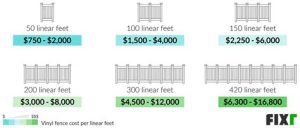Explore cultural tipping norms, discover factors influencing tips, and find recommended tipping amounts across the Midwest, Northeast, and South regions.When it comes to hiring fence installers, knowing how much to tip can be as vital as understanding the installation process itself. Tipping practices vary widely across different regions, influenced by cultural norms, service quality, and local economic conditions. For homeowners looking to express their gratitude and ensure a job well done, it’s essential to navigate these nuances carefully. In this blog post, we’ll explore the intricacies of tipping fence installers across various regions in the United States, from the Midwest to the Northeast and down to the South. By examining cultural tipping norms and the factors that affect recommendations, we’ll provide you with a comprehensive guide to ensure you tip the right amount for exceptional service.
Understanding cultural tipping norms
Tipping is often viewed as a rewarding gesture to express appreciation for good service, but the cultural norms surrounding tipping can vary significantly across different regions and professions. Understanding these norms is essential, especially when considering how much to tip fence installers, who may provide varying levels of service based on their experience and your specific project requirements.
In many cultures, tipping is not just an optional extra but a significant part of the service industry’s income. For instance, in the United States, tipping typically ranges from 15% to 20% of the total service cost, but this can fluctuate based on the difficulty of the job and the overall satisfaction with the service. Factors such as regional customs, local economic conditions, and the type of service provided all contribute to determining an appropriate tip.
For fence installers, whose job responsibilities may include heavy lifting and outdoor labor, showing appreciation can be a significant motivator. A tip can be a reflection of the quality of materials used, the professionalism displayed, and the efficiency of the installation process.
Factors affecting tipping recommendations
Tipping can vary significantly based on a number of factors that influence how much you should consider giving. Understanding these factors is essential, especially when hiring professionals like fence installers.
- Quality of Service: The level of craftsmanship, attention to detail, and professionalism exhibited by the installation team can greatly influence your tipping amount.
- Complexity of the Job: If the fence installation involves challenging terrains or additional features (like gates, decorative elements, etc.), you may want to consider tipping more.
- Time Taken: If the installers worked longer than expected or had to redo certain parts of the job, this may warrant a higher tip as compensation for their extra effort.
- Local Customs: Different regions have distinct tipping“ practices. Familiarizing yourself with local norms can help determine an appropriate tip.
- Relationship with the Installer: If you’ve previously worked with the installer or company and had a good experience, a tip can help reinforce that relationship.
By taking these factors into account when deciding how much to tip your fence installers, you ensure that your gratuity is fair and reflects their hard work and dedication.
Ultimately, considering these aspects helps uphold good service standards and acknowledges the effort the installers put into their work.
Recommended tips in the Midwest
When it comes to tipping fence installers in the Midwest, it’s important to consider the local customs and regional practices. Generally, tipping is not as prevalent in this region compared to others, but it is still appreciated by workers who take pride in their craftsmanship.
In the Midwest, a common recommendation is to tip between $20 to $50 based on the overall complexity of the job and the service provided. If the installation is particularly challenging, or if the crew goes above and beyond in their service, consider tipping on the higher end of that range.
It’s also helpful to assess the size of the crew; a crew of two may warrant a total tip of $40 to $100, depending on their performance. Remember, leaving a tip can enhance the relationship with local contractors and helps ensure quality service for future projects.
Recommended tips in the Northeast
When it comes to tipping fence installers in the Northeast, it’s essential to consider regional customs and expectations. In general, tips for service providers can vary significantly based on the location and the type of service provided.
In the Northeast, a common practice is to tip around 10-15% of the total cost of the installation. However, this can fluctuate depending on the quality of service and the complexity of the job. If the fence installation involves intricate designs or difficult conditions, it may be appropriate to lean towards the higher end of this range.
Factors influencing tipping norms in this region include local economic conditions, the reputation of the installer, and customer satisfaction with the overall service. For instance, if the team goes above and beyond your expectations by completing the job efficiently and leaving the site clean, consider a more generous tip to express your gratitude.
| Service Quality | Recommended Tip Percentage |
|---|---|
| Poor | 5% |
| Average | 10% |
| Excellent | 15-20% |
Recommended tips in the South
When it comes to tipping, the Southern United States has its own unique set of norms and expectations. Understanding these can make you feel more comfortable and ensure you’re showing appreciation in the right way. In the South, the culture is steeped in hospitality, and this extends to service workers, including fence installers.
For tipping fence installers in the South, a general guideline is to tip between 10% to 20% of the total project cost. However, this can vary based on the level of service provided and the quality of work. If the installer goes above and beyond, such as completing the job faster than expected or providing exceptional service, you might consider tipping closer to the 20% mark.
It’s also important to consider the size and complexity of the job. For smaller jobs, like repairs or minor installations, a tip of $20 to $50 can be appropriate. On larger projects, such as entire fence installations, increasing your tip to reflect the effort and time invested by the installers is a courteous gesture. Remember, a well-earned tip not only shows appreciation but also helps to foster a strong connection and goodwill.
Frequently Asked Questions
Why is it important to tip fence installers?
Tipping fence installers shows appreciation for their hard work and can incentivize them to provide better service.
What factors should influence the tip amount for fence installers?
Factors include the complexity of the job, quality of work, the region you are in, and how satisfied you are with the service.
What is the average tipping percentage for fence installers?
Typically, a tip of 10-20% of the total installation cost is considered appropriate, depending on the level of service.
Are there regional differences in tipping practices for fence installers?
Yes, tipping practices can vary by region; for example, urban areas may have higher tipping norms compared to rural areas.
Should I tip if the fence installation was part of a larger service package?
It is generally a good practice to tip if the installers provided specialized services or went above and beyond, even if it was part of a larger package.
Do all fence installation companies expect tips?
Not all companies expect tips, but most installers appreciate them as recognition of their effort and service quality.
What should I consider if I’m unsure about how much to tip?
Consider the overall service quality, how satisfied you are with the fence installation, and any regional norms or guidelines you may be aware of.





